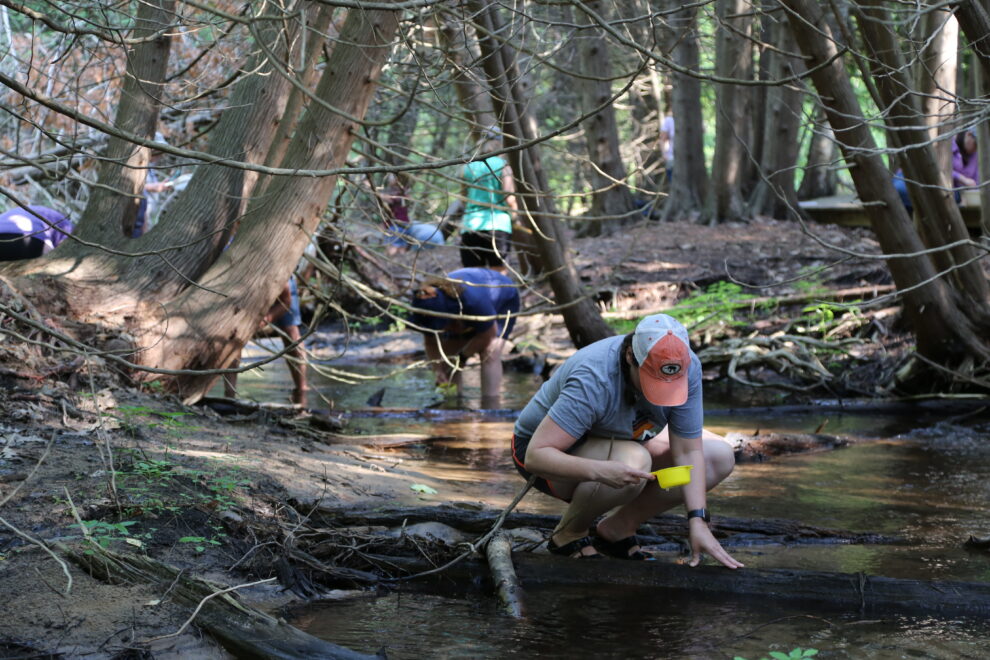Environmental education is a calling for us at ISEA. We know that the people we teach are already connected to what is happening in the natural world by their choices, good and bad, and our real aim is to move our audience toward reciprocity. At Inland Seas Education Association, we build the next generation of Great Lakes stewards through an amazing field trip, acting as sailors and scientists on a Great Lakes tall ship, then we ask them to consider behavior changes to ensure a similar experience for future participants.
Environmental education leads to environmental civic action; the more we learn about an issue the harder it is for us to remain on the sidelines, especially as we connect global phenomena to issues in our community. Many of us find ourselves embroiled in contentious conversations, because environmental civic actions are often evocative of responses from a contrarian student, an angry parent, a placating administrator. So, whether the issue is climate change or logging, mining or farming practices, dam removal or green infrastructure, I’m sharing tools that have helped me grapple with the transition from “teaching science to” to “exploring solutions with.”

Tool 1: Beetles Science and Teaching for Field Instructors Argumentation Routine
This is something I’ve used in the field with sixth graders and in the classroom with community college learners. This framework supports how to facilitate conversations around evidence-based reasoning, identifying ground rules for scientific discussions and arguments, incorporates kinesthetic learning, and helps identify which topics might lead to successful discussions around contentious topics. I especially love the scaffolds that are shared to grow conversations if open discussion is a new way of teaching for someone.
Tool 2: Yes and Nature, Climate Conversations
I recently attended a professional learning experience called ‘Climate Conversations’ that used practices in theatre and improvisation, as well as science and psychology best practices, to help educators move the needle in conversations about climate change. The folks there advocate a series of behaviors that grow your capacity for intentional conversation, whether it be at a party (ahh, the lost art of communicating with a stranger), in a conversation with a boss or employee, or on a tall ship with a climate skeptic. Each session was based on practice and had minimal lecture-style components. The skills they focused on included active listening, balancing inquiry and empathy about another’s motivations in the conversation with your own curiosity and vulnerability, and advocating with intentionality. Their program is behind a tiered paywall, but worth the experience if you have PD funds. A favorite reflection of mine was, in taking on the role of someone who was ‘climate apathetic,’ was digging into my own climate apathy/anxiety worries and being heard by someone until I reached the bottom of my own barrel. Once I had drained myself of those feelings and felt a shared connection, I felt ready to consider ‘asks’ from my conversation partner that would lift me into a space of climate action.
Tool 3: Teacher Friendly Guide to… series
I first learned about the value of place-based education when I worked at a little museum in upstate New York called Museum of the Earth. The organization wrote a regional earth science guide for every region of the US. The academics-cum-educators there saw that place-based and deep-time perspectives are key to understanding many environmental and contentious issues. They’ve written books for the curious educator who wants both content knowledge and perspective on teaching things like climate change and evolution.If you’re curious, start here, in this chapter on perspectives in Climate Change: A very short guide. Full disclosure, I am a co-author on previous iterations of some of their books.
Psychologists have taught us that human behavior doesn’t change just because we know something. To change hearts, and behaviors, environmental educators need to move beyond information into actions. ISEA offers a Great Lakes Watershed Field Course that supports educators in implementing environmental civic actions around their watersheds. We share the benefits that citizen science monitoring has had on scientists’ ability to interpret local impacts of environmental problems. We bring curiosity and vulnerability to shipboard conversations with visitors. We ask, only after they’ve raised a sail and taken a selfie, once they’ve counted 101 invasive round gobies and only two native fish, if they will become a Great Lakes steward. I hope the tools shared here will invite you to facilitate more difficult environmental conversations, and grow your teaching toward reciprocity with the environment through action. Best wishes on the journey!

This blog post was written by ISEA’s Education Coordinator Trisha Smrecak. Originally written for members of MAEOE (Michigan Alliance for Environmental & Outdoor Education) this post has been modified slightly for our audience. For more information or questions on this content contact Trisha by email at tsmrecak@schoolship.org.